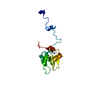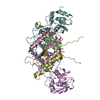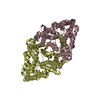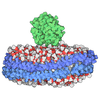+ Open data
Open data
- Basic information
Basic information
| Entry | Database: PDB / ID: 1i3o | ||||||
|---|---|---|---|---|---|---|---|
| Title | CRYSTAL STRUCTURE OF THE COMPLEX OF XIAP-BIR2 AND CASPASE 3 | ||||||
 Components Components |
| ||||||
 Keywords Keywords | APOPTOSIS / complex / IAP / caspase | ||||||
| Function / homology |  Function and homology information Function and homology informationregulation of apoptosis involved in tissue homeostasis / positive regulation of protein linear polyubiquitination / copper ion homeostasis / regulation of BMP signaling pathway / caspase-3 / phospholipase A2 activator activity / Stimulation of the cell death response by PAK-2p34 / anterior neural tube closure / intrinsic apoptotic signaling pathway in response to osmotic stress / regulation of nucleotide-binding domain, leucine rich repeat containing receptor signaling pathway ...regulation of apoptosis involved in tissue homeostasis / positive regulation of protein linear polyubiquitination / copper ion homeostasis / regulation of BMP signaling pathway / caspase-3 / phospholipase A2 activator activity / Stimulation of the cell death response by PAK-2p34 / anterior neural tube closure / intrinsic apoptotic signaling pathway in response to osmotic stress / regulation of nucleotide-binding domain, leucine rich repeat containing receptor signaling pathway / nucleotide-binding oligomerization domain containing 1 signaling pathway / leukocyte apoptotic process / positive regulation of pyroptotic inflammatory response / glial cell apoptotic process / NADE modulates death signalling / luteolysis / response to cobalt ion / cellular response to staurosporine / cyclin-dependent protein serine/threonine kinase inhibitor activity / death-inducing signaling complex / Apoptosis induced DNA fragmentation / Apoptotic cleavage of cell adhesion proteins / nucleotide-binding oligomerization domain containing 2 signaling pathway / Caspase activation via Dependence Receptors in the absence of ligand / SMAC, XIAP-regulated apoptotic response / cysteine-type endopeptidase inhibitor activity involved in apoptotic process / Activation of caspases through apoptosome-mediated cleavage / Signaling by Hippo / Regulation of the apoptosome activity / SMAC (DIABLO) binds to IAPs / SMAC(DIABLO)-mediated dissociation of IAP:caspase complexes / axonal fasciculation / regulation of synaptic vesicle cycle / death receptor binding / fibroblast apoptotic process / epithelial cell apoptotic process / TNFR1-induced proapoptotic signaling / platelet formation / RIPK1-mediated regulated necrosis / Other interleukin signaling / response to anesthetic / execution phase of apoptosis / negative regulation of cytokine production / positive regulation of amyloid-beta formation / regulation of innate immune response / Apoptotic cleavage of cellular proteins / negative regulation of B cell proliferation / pyroptotic inflammatory response / neurotrophin TRK receptor signaling pathway / negative regulation of activated T cell proliferation / negative regulation of cell cycle / response to tumor necrosis factor / T cell homeostasis / B cell homeostasis / protein K63-linked ubiquitination / positive regulation of type I interferon production / Pyroptosis / cell fate commitment / regulation of macroautophagy / Caspase-mediated cleavage of cytoskeletal proteins / negative regulation of tumor necrosis factor-mediated signaling pathway / response to X-ray / cysteine-type endopeptidase inhibitor activity / response to amino acid / response to glucose / response to UV / keratinocyte differentiation / Degradation of the extracellular matrix / striated muscle cell differentiation / intrinsic apoptotic signaling pathway / protein serine/threonine kinase binding / Regulation of PTEN localization / response to glucocorticoid / protein maturation / positive regulation of protein ubiquitination / erythrocyte differentiation / TNFR1-induced NF-kappa-B signaling pathway / response to nicotine / positive regulation of JNK cascade / hippocampus development / Deactivation of the beta-catenin transactivating complex / apoptotic signaling pathway / enzyme activator activity / Regulation of TNFR1 signaling / protein catabolic process / response to hydrogen peroxide / sensory perception of sound / RING-type E3 ubiquitin transferase / regulation of protein stability / protein processing / Regulation of necroptotic cell death / response to wounding / Regulation of PTEN stability and activity / Wnt signaling pathway / neuron differentiation / ubiquitin-protein transferase activity / ubiquitin protein ligase activity / positive regulation of canonical Wnt signaling pathway / response to estradiol / peptidase activity Similarity search - Function | ||||||
| Biological species |  Homo sapiens (human) Homo sapiens (human) | ||||||
| Method |  X-RAY DIFFRACTION / X-RAY DIFFRACTION /  SYNCHROTRON / Resolution: 2.7 Å SYNCHROTRON / Resolution: 2.7 Å | ||||||
 Authors Authors | Riedl, S.J. / Renatus, M. / Schwarzenbacher, R. / Zhou, Q. / Sun, C. / Fesik, S.W. / Liddington, R.C. / Salvesen, G.S. | ||||||
 Citation Citation |  Journal: Cell(Cambridge,Mass.) / Year: 2001 Journal: Cell(Cambridge,Mass.) / Year: 2001Title: Structural basis for the inhibition of caspase-3 by XIAP. Authors: Riedl, S.J. / Renatus, M. / Schwarzenbacher, R. / Zhou, Q. / Sun, C. / Fesik, S.W. / Liddington, R.C. / Salvesen, G.S. | ||||||
| History |
|
- Structure visualization
Structure visualization
| Structure viewer | Molecule:  Molmil Molmil Jmol/JSmol Jmol/JSmol |
|---|
- Downloads & links
Downloads & links
- Download
Download
| PDBx/mmCIF format |  1i3o.cif.gz 1i3o.cif.gz | 150.7 KB | Display |  PDBx/mmCIF format PDBx/mmCIF format |
|---|---|---|---|---|
| PDB format |  pdb1i3o.ent.gz pdb1i3o.ent.gz | 117.8 KB | Display |  PDB format PDB format |
| PDBx/mmJSON format |  1i3o.json.gz 1i3o.json.gz | Tree view |  PDBx/mmJSON format PDBx/mmJSON format | |
| Others |  Other downloads Other downloads |
-Validation report
| Summary document |  1i3o_validation.pdf.gz 1i3o_validation.pdf.gz | 409 KB | Display |  wwPDB validaton report wwPDB validaton report |
|---|---|---|---|---|
| Full document |  1i3o_full_validation.pdf.gz 1i3o_full_validation.pdf.gz | 430.3 KB | Display | |
| Data in XML |  1i3o_validation.xml.gz 1i3o_validation.xml.gz | 17.3 KB | Display | |
| Data in CIF |  1i3o_validation.cif.gz 1i3o_validation.cif.gz | 25.8 KB | Display | |
| Arichive directory |  https://data.pdbj.org/pub/pdb/validation_reports/i3/1i3o https://data.pdbj.org/pub/pdb/validation_reports/i3/1i3o ftp://data.pdbj.org/pub/pdb/validation_reports/i3/1i3o ftp://data.pdbj.org/pub/pdb/validation_reports/i3/1i3o | HTTPS FTP |
-Related structure data
- Links
Links
- Assembly
Assembly
| Deposited unit | 
| ||||||||
|---|---|---|---|---|---|---|---|---|---|
| 1 |
| ||||||||
| Unit cell |
|
- Components
Components
| #1: Protein | Mass: 19727.279 Da / Num. of mol.: 2 / Fragment: APOPAIN P17 SUBUNIT / Mutation: C285A Source method: isolated from a genetically manipulated source Source: (gene. exp.)  Homo sapiens (human) / Gene: I39005 / Plasmid: PET23B / Species (production host): Escherichia coli / Production host: Homo sapiens (human) / Gene: I39005 / Plasmid: PET23B / Species (production host): Escherichia coli / Production host:  References: UniProt: P42574, Hydrolases; Acting on peptide bonds (peptidases); Cysteine endopeptidases #2: Protein | Mass: 12981.756 Da / Num. of mol.: 2 / Fragment: APOPAIN P12 SUBUNIT Source method: isolated from a genetically manipulated source Source: (gene. exp.)  Homo sapiens (human) / Gene: I39005 / Plasmid: PET23B / Species (production host): Escherichia coli / Production host: Homo sapiens (human) / Gene: I39005 / Plasmid: PET23B / Species (production host): Escherichia coli / Production host:  References: UniProt: P42574, Hydrolases; Acting on peptide bonds (peptidases); Cysteine endopeptidases #3: Protein | Mass: 13993.578 Da / Num. of mol.: 2 / Fragment: XIAP-BIR2 / Mutation: C202A, C213G Source method: isolated from a genetically manipulated source Source: (gene. exp.)  Homo sapiens (human) / Gene: U32974 / Plasmid: PET15B / Species (production host): Escherichia coli / Production host: Homo sapiens (human) / Gene: U32974 / Plasmid: PET15B / Species (production host): Escherichia coli / Production host:  #4: Chemical | #5: Water | ChemComp-HOH / | |
|---|
-Experimental details
-Experiment
| Experiment | Method:  X-RAY DIFFRACTION / Number of used crystals: 1 X-RAY DIFFRACTION / Number of used crystals: 1 |
|---|
- Sample preparation
Sample preparation
| Crystal | Density Matthews: 2.61 Å3/Da / Density % sol: 60.14 % | ||||||||||||||||||||||||||||||||||||||||||
|---|---|---|---|---|---|---|---|---|---|---|---|---|---|---|---|---|---|---|---|---|---|---|---|---|---|---|---|---|---|---|---|---|---|---|---|---|---|---|---|---|---|---|---|
| Crystal grow | Temperature: 295 K / Method: vapor diffusion, sitting drop / pH: 5.2 Details: sodium formate, sodium acetate, pH 5.2, VAPOR DIFFUSION, SITTING DROP, temperature 295K | ||||||||||||||||||||||||||||||||||||||||||
| Crystal grow | *PLUS Temperature: 23 ℃ / pH: 7.6 | ||||||||||||||||||||||||||||||||||||||||||
| Components of the solutions | *PLUS
|
-Data collection
| Diffraction | Mean temperature: 100 K |
|---|---|
| Diffraction source | Source:  SYNCHROTRON / Site: SYNCHROTRON / Site:  SSRL SSRL  / Beamline: BL7-1 / Wavelength: 1.08 Å / Beamline: BL7-1 / Wavelength: 1.08 Å |
| Detector | Type: MARRESEARCH / Detector: IMAGE PLATE / Date: Dec 15, 2000 |
| Radiation | Protocol: SINGLE WAVELENGTH / Monochromatic (M) / Laue (L): M / Scattering type: x-ray |
| Radiation wavelength | Wavelength: 1.08 Å / Relative weight: 1 |
| Reflection | Resolution: 2.7→500 Å / Num. all: 174633 / Num. obs: 27119 / % possible obs: 99.4 % / Redundancy: 5 % / Biso Wilson estimate: 30 Å2 / Rmerge(I) obs: 0.062 |
| Reflection shell | Resolution: 2.7→2.8 Å / Redundancy: 4.5 % / Rmerge(I) obs: 0.424 / Mean I/σ(I) obs: 2.3 / Num. unique all: 2649 / % possible all: 99.3 |
| Reflection | *PLUS Lowest resolution: 500 Å / Num. measured all: 174633 |
| Reflection shell | *PLUS % possible obs: 99.3 % |
- Processing
Processing
| Software |
| ||||||||||||||||||||||||||||||||||||||||||||||||||||||||||||
|---|---|---|---|---|---|---|---|---|---|---|---|---|---|---|---|---|---|---|---|---|---|---|---|---|---|---|---|---|---|---|---|---|---|---|---|---|---|---|---|---|---|---|---|---|---|---|---|---|---|---|---|---|---|---|---|---|---|---|---|---|---|
| Refinement | Starting model: PDB ENTRY 1PAU and PDB ENTRY 1C9Q Resolution: 2.7→500 Å / Cross valid method: THROUGHOUT / σ(F): 0 / σ(I): 0 / Stereochemistry target values: Engh & Huber / Details: MLF
| ||||||||||||||||||||||||||||||||||||||||||||||||||||||||||||
| Solvent computation | Solvent model: CNS BULK SOLVENT / Bsol: 33.0707 Å2 / ksol: 0.321299 e/Å3 | ||||||||||||||||||||||||||||||||||||||||||||||||||||||||||||
| Displacement parameters | Biso mean: 29.938 Å2
| ||||||||||||||||||||||||||||||||||||||||||||||||||||||||||||
| Refinement step | Cycle: LAST / Resolution: 2.7→500 Å
| ||||||||||||||||||||||||||||||||||||||||||||||||||||||||||||
| Refine LS restraints |
| ||||||||||||||||||||||||||||||||||||||||||||||||||||||||||||
| Xplor file |
| ||||||||||||||||||||||||||||||||||||||||||||||||||||||||||||
| Software | *PLUS Name: CNS / Version: 1 / Classification: refinement | ||||||||||||||||||||||||||||||||||||||||||||||||||||||||||||
| Refinement | *PLUS Highest resolution: 2.7 Å / Lowest resolution: 500 Å / σ(F): 0 / % reflection Rfree: 5 % / Rfactor obs: 0.248 | ||||||||||||||||||||||||||||||||||||||||||||||||||||||||||||
| Solvent computation | *PLUS | ||||||||||||||||||||||||||||||||||||||||||||||||||||||||||||
| Displacement parameters | *PLUS | ||||||||||||||||||||||||||||||||||||||||||||||||||||||||||||
| Refine LS restraints | *PLUS
|
 Movie
Movie Controller
Controller













 PDBj
PDBj





















